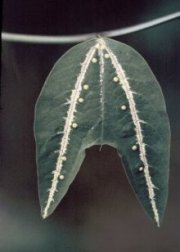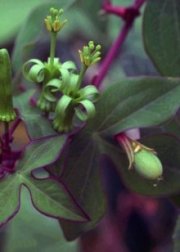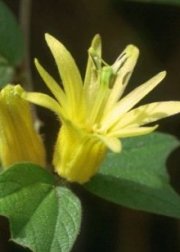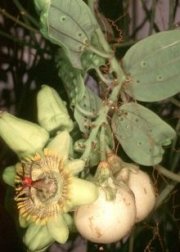| |
Passiflora subgenus Decaloba - its supersections and species
By J.M. MacDougal, K. Porter-Utley, S. Krosnick, & P.M. Jørgensen
Passiflora Subg. Decaloba
(DC.) Rchb. Consp. Regn. Veg. 132. 1828.
Basionym: Passiflora sect. Decaloba
DC. Mem. Soc. Phys. Geneve 1: 435. 1822.
Woody vines or canopy lianas to small climbers, perennials or rarely annuals; plants glabrous to
very pubescent. Stem terete, striate, grooved, angulate, or 3-5-angled; posture of new growth
at shoot tip cernuous or erect. Stipules setaceous, subulate, or narrowly falcate, sometimes foliose.
Leaves with palmate venation, often with 3 main veins, trilobed, bilobed (the center vein then shortest),
or unlobed, often variegated in juveniles; leaf margins entire or rarely dentate to serrate; petiolar
nectaries 2 (4+) and raised up from the petiole, or absent; laminar nectaries marginal, submarginal, or
as dots between the main veins, or sometimes absent. Prophylls of vegetative bud 1, 2, or rarely
more. Primary floral peduncle present (only in 3 spp. of supersect. Pterosperma) or usually
(reduced and) absent, therefore tendrils either borne from inflorescence or usually sessile-axillary;
(secondary order) peduncles 3-bracteate, 1-20-flowered. Flowers generally less than 4 cm diam.,
mostly greenish-white, rarely red, floral cup/hypanthium shallow, rarely with a floral tube; petals in
size similar to sepals, or much reduced, occasionally absent; coronal filaments in (1) 2-3 (4)
series, usually yellowish or whitish, sometimes with red to purplish bands, especially at base;
operculum membranous, plicate; limen short, fleshy; pollen spheroid to prolate, reticulate, 6-12 c
olporate; styles slender, stigmas mostly capitate. Fruits mostly small dark purplish berries, or
greenish, yellow, orange, or reddish, sometimes dehiscent capsules or capsule-like berries; seeds
reticulate, alveolate, or transversely grooved with the ridges often rugulose. Germination epigeal,
very rarely hypogeal. Chloroplast intron rpoC1 present or absent. Chromosomes mostly n=6,
but also 7, 9, (11?), or 12, with limited tetraploidy based on x=6.
Subgenus Decaloba comprises ca. 235 species and is currently divided into eight supersections
(Feuillet & MacDougal 2003 [2004]), seven of which are found in the New World (224 species), while
the eighth supersection comprises all Old World members (21 species).
|
Key to Supersections of Passiflora subgenus Decaloba |
|
1. Petiolar nectaries present as (1)2–10 sessile or
stipitate glands, generally occurring in subopposite pairs and of diverse form including
cupiform, discoid, short-cylindric, clavate, capitate, obovoid, subglobose, or auriculate. |
2 |
| |
2. Petiolar nectaries 4–10 (2–5 pairs); leaf blade
unlobed; stipules 0.2–1.2 x 0.1–0.2 mm; flowers attached to tendril or borne from
leaf axil; shoot apex cernuous; seeds 6–12 mm long. |
Supersect. Pterosperma |
| |
2. Petiolar nectaries 2 (1 pair); leaf blade lobed or unlobed;
stipules 0.5–27 x 0.2–45 mm; flowers borne from leaf axil; shoot apex straight or
cernuous; seeds 3–9 mm long. |
3 |
| |
|
3. Stipules 5–27 x 11–45 mm, foliose, clasping, with
one prominent primary vein near the center of the stipule; floral bracts 2 or a third
conspicuously smaller proximal bract sometimes present, the 2 distal bracts 6–62 x
9–64 mm, foliose; stem completely glabrous; shoot apex cernuous. |
Supersect. Hahniopathanthus |
| |
|
3. Stipules 0.5–16(–23) x 0.2–6(–15) mm,
setaceous, subulate, narrowly triangular, falcate, ovate, or obovate, if foliose or clasping
then one primary vein near one margin of the stipule, or a single prominent center vein not
obvious; floral bracts 3 and similar in size and form, or 2 and setaceous, or absent, when
present 1.3–18 x 0.2–15 mm, setaceous to foliose; stem glabrous or pubescent;
shoot apex straight. |
4 |
| |
|
|
4. Plants native to the Old World, not introduced to New World;
leaf margins entire; bracts 0.1–0.5 mm wide; petals present; trichomes never sharply
uncinate. |
Supersect. Disemma |
| |
|
|
4. Plants native to the New World, rarely introduced to Old
World; leaf margins entire, or serrate to dentate at least at base in Supersect.
Bryonioides; bracts 0.1–15 mm wide, occasionally bracts absent in Supersect.
Cieca; petals present, or absent in Supersect. Cieca; trichomes various,
sharply uncinate in Supersect. Bryonioides. |
5 |
| |
|
|
|
5. Petals absent; floral bracts 2, 1, or absent. |
Supersect. Cieca |
| |
|
|
|
5. Petals present; floral bracts 3. |
6 |
| |
|
|
|
|
6. Plants pubescent (at least at nodes and apices of
petioles) with sharply uncinate trichomes. |
Supersect. Bryonioides |
| |
|
|
|
|
6. Plants glabrescent or variously pubescent with
straight or curved but not uncinate trichomes. |
7 |
| |
|
|
|
|
|
7. Petiolar nectaries borne on basal half of petiole,
very conspicuous, the glands often auricular; petals linear, less than 2 mm wide;
peduncles uniflorous; moist lowlands. |
Supersect. Auriculata |
| |
|
|
|
|
|
7. Petiolar nectaries borne variously along petiole,
conspicuous or not, the glands not auricular; petals linear to oblong or narrowly
ovate, 2 mm wide or wider; peduncles uniflorous or branched and multiflorous; lowlands
to over 3000 m. |
Supersect. Multiflora |
|
1. Petiolar nectaries absent. |
8 |
| |
8. Stipules 5–27 x 11–45 mm, foliose, clasping;
floral bracts 2 or a third conspicuously smaller proximal bract sometimes present, the
2 distal bracts 6–62 x 9–64 mm, foliose; stem completely glabrous;
leaves with center vein longest; laminar nectaries absent or restricted to blade margins;
seed coat reticulate or pitted. |
Supersect. Hahniopathanthus |
| |
8. Stipules 0.3–13 x 0.07–10 mm, setaceous,
subulate, narrowly triangular, falcate, or rarely foliose, not clasping; floral bracts 3
and similar in size and form, or absent, when present 0.7–10(–22) x
0.05–10(–19) mm, setaceous to foliose; stem glabrous or pubescent; leaves
with center vein longest or shorter than lateral veins (leaves then appearing bilobed or
truncate); laminar nectaries present abaxially between main veins of blade, or absent,
but never marginal; seed coat transversely grooved. |
Supersect. Decaloba |
TOP
|
|




